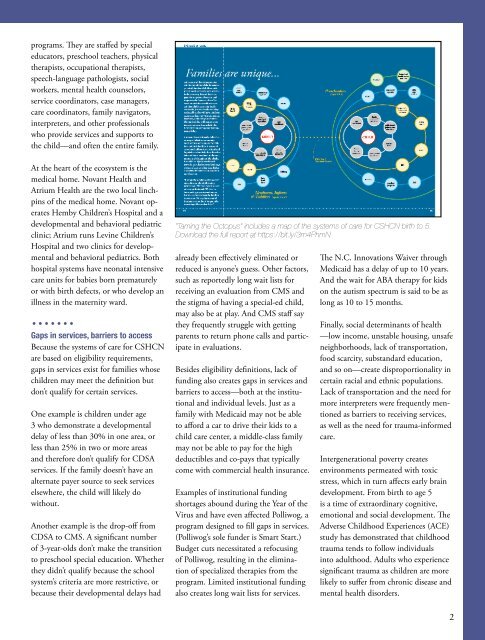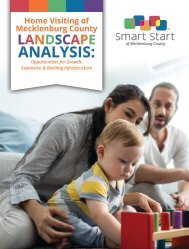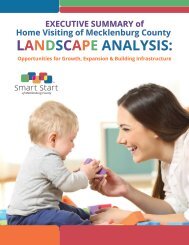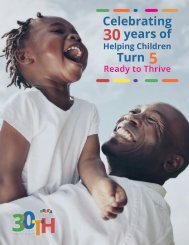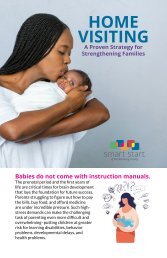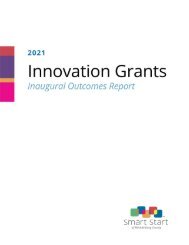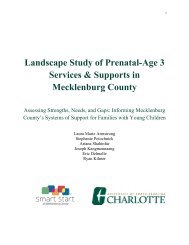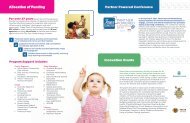Taming the Octopus - Executive Summary
Create successful ePaper yourself
Turn your PDF publications into a flip-book with our unique Google optimized e-Paper software.
programs. They are staffed by special<br />
educators, preschool teachers, physical<br />
<strong>the</strong>rapists, occupational <strong>the</strong>rapists,<br />
speech-language pathologists, social<br />
workers, mental health counselors,<br />
service coordinators, case managers,<br />
care coordinators, family navigators,<br />
interpreters, and o<strong>the</strong>r professionals<br />
who provide services and supports to<br />
<strong>the</strong> child—and often <strong>the</strong> entire family.<br />
At <strong>the</strong> heart of <strong>the</strong> ecosystem is <strong>the</strong><br />
medical home. Novant Health and<br />
Atrium Health are <strong>the</strong> two local linchpins<br />
of <strong>the</strong> medical home. Novant operates<br />
Hemby Children’s Hospital and a<br />
developmental and behavioral pediatric<br />
clinic; Atrium runs Levine Children’s<br />
Hospital and two clinics for developmental<br />
and behavioral pediatrics. Both<br />
hospital systems have neonatal intensive<br />
care units for babies born prematurely<br />
or with birth defects, or who develop an<br />
illness in <strong>the</strong> maternity ward.<br />
.......<br />
Gaps in services, barriers to access<br />
Because <strong>the</strong> systems of care for CSHCN<br />
are based on eligibility requirements,<br />
gaps in services exist for families whose<br />
children may meet <strong>the</strong> definition but<br />
don’t qualify for certain services.<br />
One example is children under age<br />
3 who demonstrate a developmental<br />
delay of less than 30% in one area, or<br />
less than 25% in two or more areas<br />
and <strong>the</strong>refore don’t qualify for CDSA<br />
services. If <strong>the</strong> family doesn’t have an<br />
alternate payer source to seek services<br />
elsewhere, <strong>the</strong> child will likely do<br />
without.<br />
Ano<strong>the</strong>r example is <strong>the</strong> drop-off from<br />
CDSA to CMS. A significant number<br />
of 3-year-olds don’t make <strong>the</strong> transition<br />
to preschool special education. Whe<strong>the</strong>r<br />
<strong>the</strong>y didn’t qualify because <strong>the</strong> school<br />
system’s criteria are more restrictive, or<br />
because <strong>the</strong>ir developmental delays had<br />
“<strong>Taming</strong> <strong>the</strong> <strong>Octopus</strong>” includes a map of <strong>the</strong> systems of care for CSHCN birth to 5.<br />
Download <strong>the</strong> full report at https://bit.ly/3m4PhmN<br />
already been effectively eliminated or<br />
reduced is anyone’s guess. O<strong>the</strong>r factors,<br />
such as reportedly long wait lists for<br />
receiving an evaluation from CMS and<br />
<strong>the</strong> stigma of having a special-ed child,<br />
may also be at play. And CMS staff say<br />
<strong>the</strong>y frequently struggle with getting<br />
parents to return phone calls and participate<br />
in evaluations.<br />
Besides eligibility definitions, lack of<br />
funding also creates gaps in services and<br />
barriers to access—both at <strong>the</strong> institutional<br />
and individual levels. Just as a<br />
family with Medicaid may not be able<br />
to afford a car to drive <strong>the</strong>ir kids to a<br />
child care center, a middle-class family<br />
may not be able to pay for <strong>the</strong> high<br />
deductibles and co-pays that typically<br />
come with commercial health insurance.<br />
Examples of institutional funding<br />
shortages abound during <strong>the</strong> Year of <strong>the</strong><br />
Virus and have even affected Polliwog, a<br />
program designed to fill gaps in services.<br />
(Polliwog’s sole funder is Smart Start.)<br />
Budget cuts necessitated a refocusing<br />
of Polliwog, resulting in <strong>the</strong> elimination<br />
of specialized <strong>the</strong>rapies from <strong>the</strong><br />
program. Limited institutional funding<br />
also creates long wait lists for services.<br />
The N.C. Innovations Waiver through<br />
Medicaid has a delay of up to 10 years.<br />
And <strong>the</strong> wait for ABA <strong>the</strong>rapy for kids<br />
on <strong>the</strong> autism spectrum is said to be as<br />
long as 10 to 15 months.<br />
Finally, social determinants of health<br />
—low income, unstable housing, unsafe<br />
neighborhoods, lack of transportation,<br />
food scarcity, substandard education,<br />
and so on—create disproportionality in<br />
certain racial and ethnic populations.<br />
Lack of transportation and <strong>the</strong> need for<br />
more interpreters were frequently mentioned<br />
as barriers to receiving services,<br />
as well as <strong>the</strong> need for trauma-informed<br />
care.<br />
Intergenerational poverty creates<br />
environments permeated with toxic<br />
stress, which in turn affects early brain<br />
development. From birth to age 5<br />
is a time of extraordinary cognitive,<br />
emotional and social development. The<br />
Adverse Childhood Experiences (ACE)<br />
study has demonstrated that childhood<br />
trauma tends to follow individuals<br />
into adulthood. Adults who experience<br />
significant trauma as children are more<br />
likely to suffer from chronic disease and<br />
mental health disorders.<br />
2


